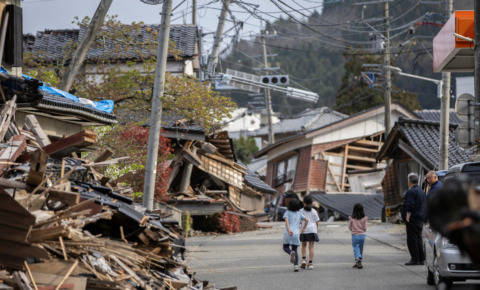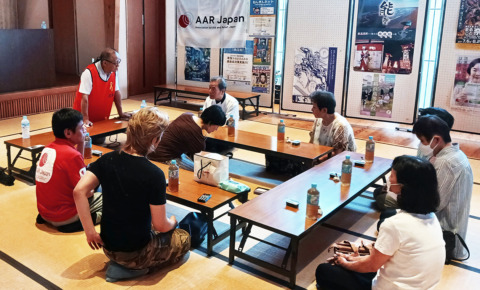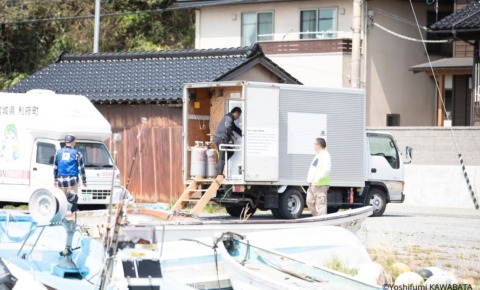Supporting survivors in temporary housing in Shika Town: Noto Peninsula Earthquake
20/05/2024
In Shika Town, Ishikawa Prefecture, which was severely damaged by the Noto Peninsula earthquake, survivors whose houses were completely or largely damaged are moving into emergency temporary housing. AAR Japan (Association for Aid and Relief Japan) is cooperating with Ishikawa Prefecture and Shika Town to provide support such as the distribution of household appliances.

AAR Shiori Kiryu visiting a temporary housing for an interview and handing out charity chocolates. The chocolates are accompanied by messages from employees of Salesforce Japan Co.,Ltd. at Togi No.3 temporary housing complex (the former site of the Togi Fisheries Cooperative warehouse) in Shika Town, Ishikawa Prefecture, April 27, 2024
Temporary housing for 194 families has been constructed in Shika Town, and move-in began in April. While the prefectural government provides same TVs, washing machines, and refrigerators to all residents, AAR’s support system allow residents to select the appliances they want from a list prepared at the move-in orientation, and the appliances will be delivered at a later date. On April 27, 21 households attended an orientation held at the Shika No.1 temporary housing meeting hall. Shika Town staff member explained about the tenancy contract and how to use water, electricity, gas, cable TV, etc., Afterwards, AAR staff members informed the residents about the home appliance application and support system.

AAR and Shika Town jointly held a move-in orientation on April 27, 2024 at Shika No.1 housing complex (former Horimatsu Nursery School)
A man in his 70s who attended the orientation said, “I am relieved that I can now move in. I brought as many usable items as I could load into my car, which I pulled out from my house that was completely destroyed.” He immediately carried his belongings into his room at the temporary housing. He said, “Sometimes I get help, but most of the time I clean up the house by myself. I get tired easily because I have a chronic illness, and it’s hard for me to go far away to drop off my belongings or to throw away disaster waste”.

A man who brought a TV, blankets, and other items to bring into the temporary housing immediately
The appliances procured by AAR have been delivered one after another. Interviews with approximately 80 households in the “Togi No. 1” to “Togi No. 3” complexes showed that the delivered products are being utilized without any problems, and the feedback was generally favorable, with the households saying, “They are very helpful.”

Some of the household appliances delivered by AAR
Cleaning up damaged houses is a challenge
During our door-to-door visits to inquire about support needs, Mr. Isao Hoshiba, 80 years old, whose house was assessed as largely damaged, invited us to his nearby house, saying “I want you to see the actual situation”. The first floor and foundation of his two-story house were damaged, and he said, “After the earthquake, I went there every day for four months to finally clean up the house. It is the house that I am very attached to, but there is no choice but to tear it down. I am going to build a small house in the same place, so please come back in about two years to see it.”
Even after the emergency period has passed, what remains as a huge burden is cleaning up and removing the damaged houses. Once a house has been assessed as “largely damaged” or more, ordinary volunteers are not allowed to enter the house, so survivors must proceed with everything at their own risk, either by themselves or with the help of relatives. Another issue common to many survivors is the lack of storage space for furniture and goods that have been pulled out.

Mr.Isao Hoshiba says, “I was in this room watching TV when the earthquake hit.”
Households that are eligible to move into temporary housing are those whose houses are “totally destroyed” or “half destroyed or more” and have no choice but to demolish their houses, and those evacuated under evacuation orders.
Although the residency period is two years from the date they move in, the publicly funded demolition of their broken houses has not progressed, making it difficult to plan for rebuilding their lives. Some survivors say, “It’s hard to be stuck in the first step of rebuilding our lives.”
For the elderly, who occupies more than half of the residents, there were some cases where the land itself had been broken and it was difficult to rebuild their homes in the same location, and they were thinking to move to other areas. In fact, some villages have been reduced from 30 households to 10 households.
While in the affected areas people continue to make strenuous efforts toward recovery, there are still many issues that cannot overcome by individuals. AAR is listening carefully to the needs of the survivors and continues to support them one by one. We would like to ask for your cooperation in AAR’s support for the Noto Peninsula earthquake.
*These activities are conducted with the generous support from Japan Platform (JPF), Salesforce Japan Co.,Ltd. and AAR volunteers
Please support
We appreciate your kind donation for our emergency relief efforts in Noto Peninsula Earthquake.
News / Report
Category
Year



